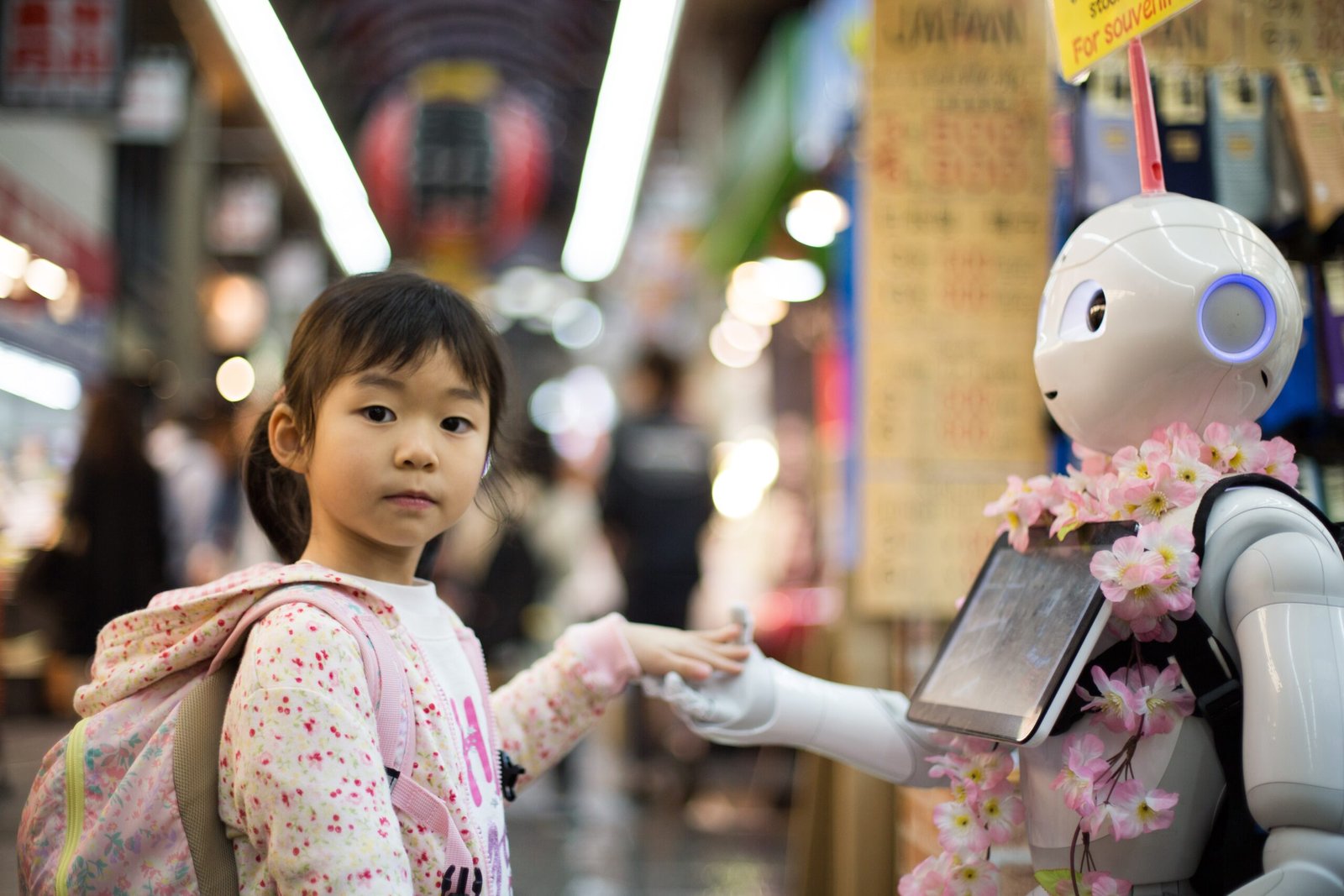Have you ever wondered about the countless possibilities of artificial intelligence? From self-driving cars to virtual assistants, the world is becoming increasingly powered by AI. But what exactly is an example of artificial intelligence? In this article, we will explore a variety of real-life scenarios where AI is making a significant impact, showcasing how this technology is revolutionizing our daily lives. So, fasten your seatbelts and get ready to embark on a journey where machines are becoming intelligent companions.
What is Artificial Intelligence?
Artificial Intelligence (AI) refers to the simulation of human intelligence in machines that are programmed to think and learn like humans. It is a branch of computer science that aims to develop intelligent systems capable of performing tasks that typically require human intelligence. These systems are designed to perceive their surroundings, understand natural language, reason, learn from experience, and make decisions based on the available information.
Definition of Artificial Intelligence
Artificial Intelligence can be defined as the ability of a machine or computer system to imitate and simulate intelligent human behavior. It involves the development of algorithms and models that enable machines to process and understand data, reason logically, and make informed decisions. AI encompasses a wide range of technologies and techniques, including machine learning, natural language processing, computer vision, and robotics.
Purpose of Artificial Intelligence
The main purpose of Artificial Intelligence is to create intelligent machines that can perform tasks autonomously, efficiently, and accurately. AI systems are designed to assist humans in various domains by augmenting their capabilities and improving their productivity. These systems can analyze large amounts of data, identify patterns and trends, and provide insights and predictions that can help in decision-making processes. Additionally, AI can automate repetitive tasks, perform complex calculations, and carry out tasks that are dangerous or impossible for humans.
Importance of Artificial Intelligence
Artificial Intelligence plays a crucial role in various aspects of our lives and has a significant impact on multiple industries. It enables businesses to optimize their operations, enhance productivity, and improve customer experiences. AI technologies are used in healthcare for disease diagnosis, treatment planning, and drug discovery. It is also widely employed in finance for fraud detection, risk assessment, and algorithmic trading. Furthermore, AI has transformed the automotive industry with self-driving vehicles, revolutionized customer service with virtual personal assistants, and improved manufacturing processes through robotics and automation. The importance of AI lies in its ability to address complex problems, enhance efficiency, and drive innovation across diverse sectors of society.
Types of Artificial Intelligence
Artificial Intelligence can be categorized into three main types based on their capabilities and limitations.
Narrow AI
Narrow AI, also known as weak AI, refers to AI systems that are designed to perform specific tasks within a limited domain. These systems excel at a single task but lack the ability to generalize their knowledge to other domains. Examples of narrow AI include facial recognition systems, language translation services, and recommendation algorithms used by streaming platforms. Narrow AI is widely applied in various industries and is more prevalent than other types of AI.
General AI
General AI, also known as strong AI or human-level AI, refers to AI systems that possess the ability to understand, learn, and apply knowledge across multiple domains, just like a human being. General AI aims to replicate all aspects of human intelligence, including reasoning, understanding natural language, and adapting to new situations. While significant progress has been made in developing narrow AI, achieving true general AI remains a challenging goal.
Superintelligent AI
Superintelligent AI refers to AI systems that surpass human intelligence in almost all aspects. These hypothetical machines would possess cognitive abilities far beyond human capabilities and would be able to solve complex problems and make decisions that humans cannot comprehend. While the idea of superintelligent AI remains more of speculation and debate, it showcases the potential future capabilities that AI could possess.

Applications of Artificial Intelligence
Artificial Intelligence finds applications in various domains and industries, revolutionizing the way we live and work. Here are some key areas where AI is making a significant impact.
Virtual Personal Assistants
Virtual personal assistants, such as Apple’s Siri, Amazon’s Alexa, and Google Assistant, are AI-powered applications that provide personalized assistance to users. These assistants can perform tasks such as setting reminders, answering questions, playing music, and controlling smart home devices, all through voice commands. They utilize natural language processing and machine learning algorithms to understand and respond to user queries effectively.
Smart Home Devices
AI has empowered smart home devices to become more intuitive and efficient. Devices like smart thermostats, lighting systems, and security cameras can learn user preferences and adapt their settings accordingly. These devices use AI algorithms to optimize energy consumption, provide personalized lighting setups, and enhance security measures. The integration of AI in smart homes allows for greater convenience and control over various aspects of daily life.
Autonomous Vehicles
Autonomous vehicles, also known as self-driving cars, rely heavily on AI to navigate and make decisions on the road. AI algorithms process data from sensors, cameras, and GPS to perceive the environment, identify obstacles, and plan the best routes. Machine learning techniques enable these vehicles to learn from past experiences and improve their decision-making capabilities over time. The development of autonomous vehicles has the potential to revolutionize transportation, making it safer, more efficient, and convenient.
Medical Diagnosis
AI has shown tremendous potential in medical diagnosis by assisting healthcare professionals in analyzing medical images and interpreting patient data. Machine learning algorithms can diagnose diseases and conditions from images like X-rays, MRI scans, and histopathological slides with high accuracy. AI-based diagnostic tools and decision support systems help doctors make informed treatment decisions, leading to improved patient outcomes and timely interventions.
Fraud Detection
Financial institutions and e-commerce platforms leverage AI for fraud detection and prevention. AI algorithms analyze vast amounts of transactional data to identify patterns and anomalies that could indicate fraudulent activities. By continuously learning from new data, AI systems can adapt to evolving fraud patterns and enhance their detection capabilities. This helps in reducing financial losses and ensuring the security of transactions.
Robotics and Automation
AI plays a critical role in robotics and automation, enabling machines to perform tasks with precision, efficiency, and adaptability. Collaborative robots, also known as cobots, work alongside humans in industries like manufacturing and healthcare. They can perform repetitive or physically demanding tasks, increasing productivity and reducing the risk of workplace injuries. AI-powered automation systems have also transformed warehouse operations by optimizing inventory management, order fulfillment, and logistics.
Natural Language Processing
Natural Language Processing (NLP) is a subfield of AI that focuses on enabling machines to understand and interpret human language. NLP algorithms can process, analyze, and generate human language for various applications. This includes sentiment analysis to gauge public opinion, language translation services, chatbots for customer service, and voice assistants for hands-free interactions. NLP enables machines to comprehend and respond to human language, facilitating seamless communication and improving user experiences.
Recommendation Systems
AI-based recommendation systems are widely used in e-commerce, media streaming platforms, and social media. These systems analyze user preferences, behavior, and purchase history to suggest relevant products, movies, or content that match their interests. By personalizing recommendations, AI enhances user engagement, improves customer satisfaction, and boosts sales for businesses.
Financial Trading
The financial industry heavily relies on AI for algorithmic trading and investment decisions. AI algorithms analyze vast amounts of market data in real-time, identifying patterns, trends, and market opportunities. By automating the trading process and making rapid decisions based on complex market conditions, AI systems can optimize trading strategies, minimize risks, and increase profitability.
Gaming
AI has significantly transformed the gaming industry, enhancing player experiences and introducing realistic virtual environments. AI-powered game agents can adapt and learn from player behavior, providing challenging and engaging gameplay. Additionally, AI techniques like procedural generation can create dynamic and immersive gaming worlds. AI-driven NPCs (non-playable characters) in games can exhibit intelligent behaviors, adding depth and realism to virtual worlds.
Machine Learning as an Example of AI
Machine Learning is a subset of AI that focuses on enabling systems to learn and improve from experience without being explicitly programmed. It involves the development of algorithms and models that allow computers to learn patterns and make predictions or decisions based on data.
Definition of Machine Learning
Machine Learning can be defined as the process of training computers or systems to learn from data and improve their performance on specific tasks over time. It involves the development of mathematical models and algorithms that automatically detect patterns and relationships in data. By analyzing and generalizing from past examples, machine learning models can make predictions or take actions in new situations.
Supervised Learning
Supervised Learning is a type of machine learning where the model is trained on labeled data, meaning the input data points have corresponding known output or target values. The model learns from these labeled examples and tries to approximate the underlying mapping or relationship between the input and output variables. Supervised learning is often used for tasks such as classification or regression, where the goal is to predict categorical labels or continuous values.
Unsupervised Learning
Unsupervised Learning is a type of machine learning where the model is trained on unlabeled data, meaning the input data points do not have corresponding known output values. The goal of unsupervised learning is to discover patterns, structures, or relationships in the data without any predefined labels. Common applications of unsupervised learning include clustering, dimensionality reduction, and anomaly detection.
Reinforcement Learning
Reinforcement Learning is a type of machine learning that focuses on training agents to learn from feedback or rewards obtained by interacting with an environment. The agent explores the environment, takes actions, and receives rewards or penalties based on the outcomes of those actions. Through trial and error, the agent learns to maximize the cumulative reward by determining the actions that lead to the desired outcomes. Reinforcement learning has been successfully applied in areas such as game playing, robotics, and optimization problems.
Deep Learning
Deep Learning is a subset of machine learning that focuses on training deep neural networks with multiple layers of interconnected nodes, also known as neurons. Deep learning models can learn hierarchical representations of data, enabling them to automatically extract useful features and patterns from raw input. This makes deep learning particularly effective in tasks such as image recognition, speech and text processing, and natural language understanding. Neural networks in deep learning are inspired by the structure and function of the human brain, allowing them to process complex information and make accurate predictions.

Virtual Personal Assistants as an Example of AI
Virtual Personal Assistants (VPAs) are AI-powered applications that provide personalized assistance to users. They leverage natural language processing, machine learning, and voice recognition technologies to understand and respond to user queries and requests.
Overview of Virtual Personal Assistants
Virtual Personal Assistants are designed to assist users in various tasks by leveraging AI technologies. They are typically found in smartphones, smart speakers, and other devices that can connect to the internet. VPAs aim to provide a seamless and intuitive user experience by understanding natural language and providing relevant and personalized information or services.
Popular Virtual Personal Assistants
There are several popular virtual personal assistants available, each with its own unique capabilities and functionalities. Some of the most widely used VPAs include Apple’s Siri, Amazon’s Alexa, Google Assistant, and Microsoft’s Cortana. These VPAs are integrated into a variety of devices, including smartphones, smart speakers, and smart home devices.
Functions and Capabilities
Virtual Personal Assistants can perform a wide range of functions and tasks to assist users in their daily lives. They can answer questions, provide weather forecasts, set reminders and alarms, schedule appointments, send text messages, make phone calls, play music, and even control smart home devices. VPAs can also provide personalized recommendations based on user preferences and past interactions. Their capabilities are continually expanding as AI technologies advance.
Voice Recognition and Natural Language Processing
The key technologies that enable Virtual Personal Assistants to understand and respond to user queries are voice recognition and natural language processing. Voice recognition algorithms convert spoken words into text, allowing the VPA to understand the user’s commands. Natural language processing algorithms then analyze the text to extract meaning, identify the user’s intent, and generate appropriate responses. These technologies enable VPAs to provide conversational interactions and deliver accurate and relevant information.
Smart Home Integration
Virtual Personal Assistants can seamlessly integrate with smart home devices and enable users to control various aspects of their homes through voice commands. By connecting to compatible smart devices such as lighting systems, thermostats, security cameras, and entertainment systems, VPAs allow users to automate and control their smart homes conveniently. For example, users can ask the VPA to dim the lights, adjust the temperature, or play music in a specific room. This integration enhances the overall smart home experience and adds an extra layer of convenience and control for users.
Autonomous Vehicles as an Example of AI
Autonomous Vehicles, also known as self-driving cars, utilize AI technologies to navigate and make decisions on the road without human intervention. These vehicles leverage sensors, perception systems, and machine learning algorithms to detect and respond to their surroundings.
Overview of Autonomous Vehicles
Autonomous vehicles are vehicles equipped with sensors, cameras, and AI software that enable them to perceive the environment and make decisions based on the collected data. The ultimate goal of autonomous vehicles is to operate safely and efficiently without human involvement. They have the potential to revolutionize transportation by reducing accidents, improving traffic flow, and providing increased mobility for individuals unable to drive.
Artificial Intelligence in Self-Driving Cars
Artificial Intelligence is at the core of self-driving cars, enabling them to navigate and make decisions autonomously. AI algorithms process data from various sensors, including cameras, radar, lidar, and GPS, to perceive the vehicle’s surroundings. These algorithms interpret the data, detect objects, recognize road markings and signs, and predict the behavior of other road users. By analyzing and understanding the environment in real-time, autonomous vehicles can make informed decisions and execute appropriate actions, such as accelerating, braking, or changing lanes.
Sensors and Perception Systems
Autonomous vehicles rely on a combination of sensors and perception systems to perceive their environment accurately. Cameras capture visual information, allowing the vehicle to detect obstacles, traffic signs, and lane markings. Radar sensors measure the distance and speed of objects, providing valuable information for collision avoidance and adaptive cruise control. Lidar sensors use laser beams to create detailed 3D maps of the surroundings, helping the vehicle identify objects and navigate complex environments. GPS receivers provide localization information, enabling the vehicle to pinpoint its position on the road.
Machine Learning for Decision Making
Machine Learning algorithms play a crucial role in autonomous vehicles’ decision-making processes. These algorithms learn from vast amounts of data collected during training, including real-world driving scenarios and human driving behavior. By analyzing this data, the autonomous vehicle can learn to make decisions based on patterns and relationships detected in the training data. Machine learning enables the vehicle to adapt to various driving conditions, handle complex scenarios, and improve its overall performance over time.
Challenges and Future of Autonomous Vehicles
While autonomous vehicles hold immense promise, there are still significant challenges to overcome before they become commonplace on our roads. Safety concerns, legal and regulatory frameworks, and public acceptance are among the key challenges. Validating the safety and reliability of autonomous vehicles across all possible scenarios remains a complex task. Additionally, the need for robust cybersecurity measures to protect the AI systems from potential attacks is vital. As technology continues to evolve and regulatory frameworks are established, the future of autonomous vehicles holds the potential to transform transportation, making it safer, more efficient, and accessible to all.

Medical Diagnosis as an Example of AI
Artificial Intelligence has emerged as a powerful tool in medical diagnosis, assisting healthcare professionals in analyzing complex data and making accurate diagnoses. AI-based systems leverage machine learning and computer vision techniques to interpret medical images, detect diseases, and enhance clinical decision-making.
Role of AI in Medical Diagnosis
AI has the potential to significantly improve medical diagnosis by assisting healthcare professionals in interpreting medical images, analyzing patient data, and predicting disease outcomes. Medical diagnosis often involves complex patterns and subtle manifestations that can be challenging for human experts to detect. AI systems can process large amounts of medical data, identify patterns, and generate insights that aid in accurate disease identification and prognosis.
Machine Learning in Medical Imaging
Medical imaging plays a crucial role in diagnosing and monitoring various diseases. AI algorithms can analyze medical images, such as X-rays, MRIs, CT scans, and ultrasounds, to detect abnormalities, lesions, or tumors. Machine learning models can learn from a vast amount of labeled medical images, enabling them to classify diseases, provide risk assessments, and recommend further diagnostic tests. The application of AI in medical imaging accelerates the diagnostic process, improves accuracy, and reduces variability between different clinicians.
Diagnostic Algorithms and Decision Support Systems
AI-based diagnostic algorithms and decision support systems assist healthcare professionals in formulating accurate diagnoses and treatment plans. These systems analyze patient data, including medical history, symptoms, laboratory results, and genetic information, to generate predictions and risk assessments. By comparing new patient data to existing databases and incorporating knowledge from medical literature, AI systems can provide valuable insights to support clinical decision-making.
Enhancing Clinical Decision Making
AI systems augment the clinical decision-making process by providing healthcare professionals with evidence-based recommendations. Machine learning models can analyze vast amounts of patient data, treatment outcomes, and clinical guidelines to identify the most effective treatment options. By taking into account individual patient characteristics and preferences, AI systems can assist in personalized medicine and improve patient outcomes.
Challenges and Ethical Considerations
While AI holds great promise in medical diagnosis, there are challenges and ethical considerations that need to be addressed. Medical AI systems must be thoroughly validated and tested to ensure accuracy and reliability. The potential for biases in training data and algorithms must be carefully addressed to avoid disparities and inequalities in healthcare delivery. Additionally, concerns regarding patient privacy, data security, and the need for human oversight and accountability need to be carefully managed to maintain trust and ensure patient safety.
Natural Language Processing as an Example of AI
Natural Language Processing (NLP) focuses on enabling machines to understand and interpret human language. NLP plays a vital role in various AI applications, including text analysis, language translation, chatbots, and customer service.
Definition of Natural Language Processing
Natural Language Processing is a subfield of AI that involves the interaction between computers and human language. NLP aims to enable machines to understand, interpret, and generate human language in a meaningful way. It involves the development of algorithms and models that can process, analyze, and generate natural language for various applications.
Text Analysis and Sentiment Analysis
Text analysis is a crucial application of NLP that involves extracting meaning and insights from text data. NLP algorithms can analyze large volumes of text documents, such as social media posts, reviews, and customer feedback, to identify patterns, sentiment, and topics. Sentiment analysis, a specific branch of text analysis, focuses on determining the sentiment or emotion expressed in the text, whether it is positive, negative, or neutral. Text analysis and sentiment analysis have wide-ranging applications, including market research, social media monitoring, and customer feedback analysis.
Language Translation and Interpretation
NLP enables machines to translate text and interpret meaning across different languages. Machine translation algorithms employ NLP techniques to convert text written in one language into another while preserving the original meaning. Language translation is widely used in applications like online language translation services, real-time interpretation during international conferences, and localization of software and websites.
Chatbots and Virtual Assistants
Chatbots and virtual assistants utilize NLP to understand and respond to user queries and requests in a conversational manner. These AI-powered systems can engage in dialogues with users, provide information, answer frequently asked questions, and offer support across various domains. NLP algorithms enable chatbots and virtual assistants to understand the user’s intent, extract relevant information, and generate appropriate responses. They enhance customer service and support by providing instant and personalized assistance.
Applications in Customer Service and Support
NLP has transformed customer service and support by enabling businesses to provide efficient and personalized assistance to their customers. NLP-powered chatbots and virtual assistants can handle a wide range of customer queries, requests, and complaints. They can provide self-service options, guide customers through various processes, and escalate complex issues to human agents when necessary. NLP algorithms continuously learn from user interactions, allowing chatbots to improve their responses and deliver better customer experiences over time.
Robotics and Automation as an Example of AI
Artificial Intelligence plays a crucial role in the field of robotics and automation, enabling machines to perform tasks more efficiently, accurately, and autonomously. AI technologies have revolutionized industries such as manufacturing, healthcare, and logistics.
Role of AI in Robotics and Automation
AI in robotics and automation involves the development of intelligent machines that can perceive, reason, and make decisions to perform specific tasks. Robots equipped with AI technologies can execute complex operations, adapt to changing environments, and collaborate with humans. AI enables robots to possess human-like intelligence, improving their ability to handle complex tasks and maintain human safety.
Collaborative Robots (Cobots)
Collaborative Robots, also known as cobots, are designed to work alongside humans in a shared workspace. These robots utilize AI technologies to perform tasks collaboratively with human counterparts, ensuring efficient and safe operation. Cobots can assist humans in various tasks, such as assembly, pick-and-place operations, and quality control. The AI algorithms in cobots enable them to perceive and understand human actions, respond to changing conditions, and actively avoid collisions.
Industrial Applications
AI-powered robots have transformed various industries, particularly in manufacturing and production settings. Industrial robots equipped with AI technologies can operate autonomously, carry out repetitive tasks, and perform complex assembly operations with precision. They can also analyze sensor data in real-time to detect anomalies, prevent errors, and optimize production processes. By automating labor-intensive and tedious tasks, AI-driven robots enhance productivity, reduce costs, and improve product quality.
Warehouse Automation
AI plays a vital role in warehouse automation, which involves the use of robots and AI technologies to optimize logistics and distribution processes. Autonomous robots equipped with AI algorithms can efficiently navigate through warehouses, locate items, and retrieve or transport goods. AI-powered warehouse management systems analyze data from various sources, including inventory levels, order volumes, and delivery schedules, to optimize inventory management, minimize order fulfillment time, and increase warehouse efficiency.
Advancements in Robotic AI
Advancements in Robotic AI have led to the development of sophisticated robots with advanced capabilities. These robots can perform complex operations, adapt to dynamic environments, and learn from experiences to improve their performance. Reinforcement learning and imitation learning techniques enable robots to acquire new skills and behaviors through trial and error or by observing human actions. The integration of AI and robotics paves the way for robots that can handle human-like dexterity, understand human intentions, and interact more naturally with their surroundings.
Deep Learning as an Example of AI
Deep Learning is a subset of machine learning that focuses on training deep neural networks with multiple layers of interconnected nodes, also known as neurons. Deep Learning algorithms have achieved remarkable performance in various domains, including image and speech recognition, natural language processing, and medical diagnosis.
Definition of Deep Learning
Deep Learning is a subfield of machine learning that aims to mimic the structure and function of the human brain using artificial neural networks. Deep neural networks consist of multiple layers of interconnected nodes, where each node performs a simple computation. By training deep neural networks on large datasets, these models can learn hierarchical representations of data, automatically extracting useful features and patterns.
Neural Networks and Deep Neural Networks
Neural networks are computational models composed of interconnected nodes, or artificial neurons, that mimic the neurons in the human brain. Each node receives input, performs a computation, and produces an output. Deep neural networks are neural networks with multiple hidden layers between the input and output layers. These deep architectures enable the models to learn complex representations and perform tasks that require a high level of abstraction and understanding.
Image and Speech Recognition
Deep Learning has revolutionized image and speech recognition tasks, achieving unprecedented levels of accuracy and performance. Deep neural networks can process and analyze visual input or audio signals to identify objects, recognize faces, transcribe speech, and categorize sounds. Convolutional Neural Networks (CNNs) are particularly effective in image recognition tasks, while Recurrent Neural Networks (RNNs) are widely used in speech recognition and language modeling.
Natural Language Processing
Deep Learning has had a significant impact on natural language processing tasks, enabling machines to understand and generate human language. Deep neural networks, such as Recurrent Neural Networks (RNNs) and Transformer models, have proven effective in various NLP applications, including language translation, sentiment analysis, text generation, and question-answering. By learning from large amounts of text data, deep learning models can capture semantic and syntactic patterns, enabling more accurate and context-aware language processing.
Applications in Various Fields
Deep Learning has found applications in various fields, ranging from healthcare to finance, autonomous driving to virtual reality. In healthcare, deep learning models have demonstrated remarkable performance in medical image analysis, disease diagnosis, and drug discovery. In finance, deep learning algorithms are used for stock market prediction, fraud detection, and algorithmic trading. Deep Learning has also revolutionized the gaming industry, enabling realistic virtual environments, intelligent NPCs, and immersive gameplay experiences.
In conclusion, Artificial Intelligence is a transformative technology that has the potential to revolutionize multiple industries and improve various aspects of our lives. The different types of AI, such as Narrow AI, General AI, and Superintelligent AI, showcase the breadth of capabilities and potential future advancements in the field. AI applications, including virtual personal assistants, autonomous vehicles, medical diagnosis, natural language processing, robotics and automation, and deep learning, have already made a significant impact in various domains. Machine learning, as an example of AI, enables computers to learn from data and make accurate predictions or decisions. Virtual personal assistants and autonomous vehicles highlight how AI technologies enhance user experiences and revolutionize transportation. In the field of healthcare, AI assists in medical diagnosis, clinical decision-making, and improving patient outcomes. Natural language processing enables machines to understand and generate human language, benefiting areas such as customer service and analysis of text data. Robotics and automation, powered by AI, enhance productivity and safety in industrial settings. Finally, deep learning, with its ability to learn hierarchical representations, has achieved remarkable performance in tasks like image and speech recognition and natural language processing. As AI continues to advance, it is essential to address challenges, ethical considerations, and ensure responsible development and deployment of AI technologies for the benefit of society. Overall, artificial intelligence holds immense potential in shaping the future and improving various aspects of our lives.






